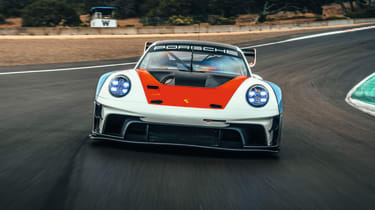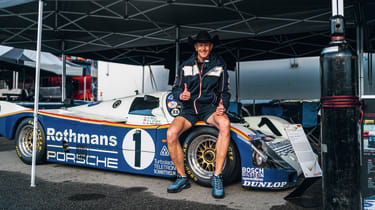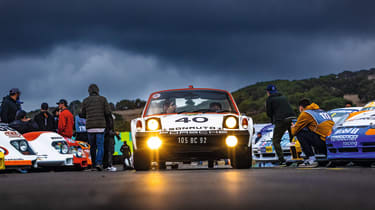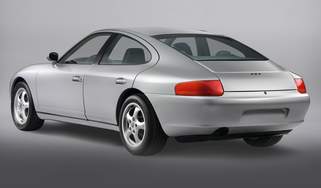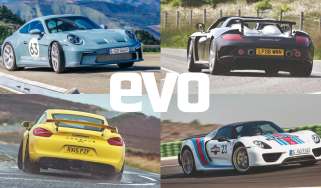Why Rennsport Reunion is the world's best Porsche gathering
It’s the world’s greatest gathering of racing Porsches. We join the legions of fans – and the legendary drivers and engineers – at Laguna Seca for the latest Rennsport Reunion
The invasion is subtle at first. The familiar rasp of a 718 Cayman GT4 as it surges past our bumbling Chevy Suburban shuttle bus. Up ahead at a stop sign sits a pair of convoying 996 Turbos; waiting to pull out of a side-road is an Outlaw-style, short-wheelbase 911 hot rod. Soon, every other car in the line of traffic is a Porsche, and those familiar front ends can be seen poking out of junctions and roadside drive-thru chains. By the time we reach Monterey itself I’m wondering if we’ve entered a strange and frankly rather appealing parallel universe, a land where you’re allowed to use the public highway only if you drive a Porsche. But no, it’s simply that Rennsport Reunion 7 is in town, an event like no other, and the passion for the sports cars from Stuttgart is palpable.
Laguna Seca Raceway is draped inside a natural bowl in the hills about 20 minutes east of Monterey. Constructed in the late 1950s, it’s rich in Californian sports car culture, its dusty hills, bleached to the colour of cinnamon, creating a natural amphitheatre and atmosphere not too dissimilar to Brands Hatch – but with appreciably better weather.
> Porsche claims new Panamera will drive more like a 911
All the greats of American motorsport have raced and won here, just as club competitors have pounded around its sun-drenched curves, immortalised for a new generation in more recent years by the likes of Gran Turismo. Not especially long at two-and-a-quarter miles, it nevertheless boasts its own significant challenges: the devilishly awkward crested left on the start/finish straight; the 180-degree turn two and, of course, the mighty Corkscrew, which falls 60ft in an instant – all are indelibly branded onto the minds of millions of car enthusiasts. And just as with Eau Rouge at Spa, or much of the Nordschleife, the gradient change is far more extreme than a games console can ever hope to convey.
For the uninitiated, Rennsport Reunion is quite simply the biggest gathering of racing Porsches in the world. Conceived by Porsche North America and British racing driver Brian Redman, the first event was held in 2001 at Lime Rock, switching to Laguna Seca in 2011 for the fourth running. The event tends to take place every three to five years, often to coincide with significant anniversaries. Think of it as a giant Porsche festival with a programme of races stretching over the weekend, from club racers with 2.5-litre Boxsters to a formidable field of 1980s Group C/IMSA prototypes, and much else besides. Porsche tractor racing? Yes, that too.
As a company Porsche is here in force, with the debut of the GT3 R Rennsport (which takes to the track at various points across the weekend) but also bringing over almost every conceivable ‘personality’ associated with the history of Porsche Motorsport, from drivers to engineers, old and new. Wolfgang Porsche is here, too, with son Ferdi: it’s a family event in more ways than one.
But we need to talk about the cars. And it says a lot that the Porsche Museum felt the need to bring over only a handful. There’s ‘number one’, the mid-engined predecessor to the very first 356 model, and a new 992 S/T in a shocking hue known as Bahama Yellow that dates back to the late 1960s. The 919 Evo LMP1 race car is here for demonstrations, and the 997 GT3 R hybrid is on static display. Almost all the other star attractions are privately owned, such is the enthusiasm of collectors worldwide, and try as I might it’s genuinely hard to come up with an example of a racing Porsche that isn’t represented. For the real diehards amongst you I can report there is no 909 Bergspyder, the ludicrous sub-400kg hill-climb special from 1968; there’s no 911 GT1-98 either, nor a long-tail 917, although there are multiple examples of both the 917K and also the turbocharged Can-Am variants…With the rows and rows of race cars strewn through the paddock, this is a gathering of important historical Porsches of a volume and depth I’ve never experienced before. At one point I feel it might have blown a fuse in my brain.
But it’s the people that are the real stars. Some 50 icons of motorsport are here – drivers such as Derek Bell, Jacky Ickx, Jochen Mass, Brian Redman, David Hobbs, Thierry Boutsen, Mark Webber, Romain Dumas…
Interrupting his breakfast, I grab a chat with Boutsen first. ‘Getting back into the car [the Group C 962], it’s like I left it the day before yesterday,’ he tells me. ‘Everything is in the same place – you get into it immediately.’ The charming Belgian, an icon of ’80s and ’90s F1 and still with that trademark bouffant hairstyle, also turns out to be a true driver’s driver: ‘I kept on driving in Group C [after signing his F1 contract] because I loved it – I really loved it.’
And where else, too, might you get time to enjoy a casual chat with someone like George Follmer, the American racer famed, amongst other things, for being the first to truly tame the twin-turbo 917/10 Can-Am car, the 1000bhp-plus racer that really started the turbocharging revolution and through its successor, the even more powerful 917/30, effectively killed the series it was designed for. Follmer, now 89, has quite the reputation for being a hard-as-nails racer, and I admit my approach is a tentative one. From under the peak of a retro baseball cap, he fixes me with the infamous ‘Follmer stare’, which wouldn’t look out of place in the finest spaghetti western, but thankfully the ends of the mouth turn upwards and we’re granted an audience.
In hushed tones, barely audible above the shrill screams of 992 Cup cars circulating outside, he provides me a priceless few moments of 917/10 discussion. If you don’t have an appreciation of the model, imagine a small, spyder-bodied racing car, almost as wide as it is short, with a flimsy space-frame chassis that offers no frontal impact protection whatsoever, powered by a 5.4-litre twin-turbo flat-twelve with epic turbo lag and even more ludicrous thrust.
‘The 917/10 was good here; it was good most places – you just had to make it behave itself,’ Follmer tells me, with the steely demeanour of someone who’d stare down a rattlesnake without flinching. ‘I seemed to have the touch, because I got a lot out of it; left black marks a lot of places.’ Chuckles. ‘The secret was anticipation – being ahead of the lag. A lot of guys that drove them drove them well but didn’t get a lot out of them because they waited for the car. When I went in a corner I wanted all that power coming out, so I didn’t wait, just had to make sure it was pointing in the right direction. Sometimes it would spin its wheels, it would depend how many rpms the engine had on it. They were difficult because they had a lot of power and to take advantage of it you had to kind of hang your ass out a little bit, but if you didn’t mind doing that, it would go like hell.’
After a chat with Norbert Singer, the absolute godfather of Porsche race-car design, I find the legend that is Derek Bell, now 81, looking tanned, fit and healthy in shirt, blue jeans and trainers. After a few stories about the old days, as hilarious as they are unprintable, he’s told he’s needed in the paddock, and he’s off, me in tow. It’s quite an eye-opener, finding out what it’s like to be a Great White in a shoal of small fish, the crowds parting before us before wrapping in behind and following, phones held aloft.
It’s not just the cars that are varied in the paddock, but the entrants too. There are the wealthy collectors such as Malcolm Ross with his ex-works ‘Rothmans’ 962C, car and team truck meticulously prepared. But then there are those on a smaller budget, albeit no less enthusiastic, like Brian Lowrance of Porsche specialist Reno Rennsport, who’s racing a heavily modded 911 with what appears to be a chopped-down roof. ‘It was a ’69 911, kinda rusty, and I built it to be a spec 911 [equivalent to a 2.0L Cup]. It was really competitive about five years ago. Now it’s built for the GT3 class in the Porsche Club America Championship. It’s a 3.6-litre full race motor, 915 trans, Tractive suspension. Inch-and-a-half lower roof, no gutters. My dad ran the IMSA Camel GT series in the ’80s and ’90s, so he was building Porsche tube-frame cars. He did all kinds of shit like this. Lots of little tricks from him. This is a great event – this is probably the most people this car will ever race in front of!’
To put a number on it, that’s 90,000 people, for an event that sold out in advance. The queue for the official Porsche merch shop rarely drops below a two-hour wait time. And we haven’t talked about the public car park filled with Porsches (non-Porsches are parked over the hill, out of sight), or the trade village, and on it goes…
The phrase most often heard over the weekend is ‘What other brand could do an event like this?’ It’s a fair question. Ferrari, maybe, but it would have a very different vibe. Mercedes, perhaps, but arguably not to this level. The key to Rennsport Reunion is that there are five-grand Boxsters here, just as there are easily ten 959s. Whatever the budget, just about anyone can be part of this family. If you’re a Porsche fan, start planning a visit to the next one now.
This story was first featured in evo issue 316.


